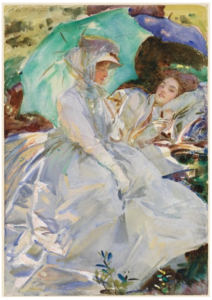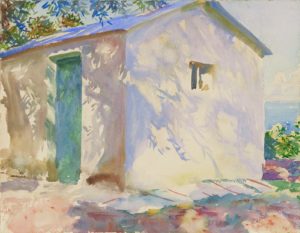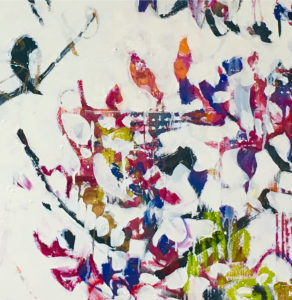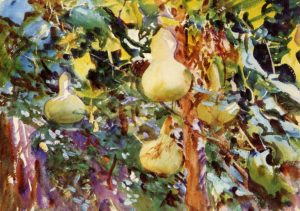Dear Artist,
Last week Molly VanZant of Lexington, Kentucky wrote, “I’m an artist at the beginning of my journey toward a well-made watercolour. Recently, I took down some paintings stashed on the top of my cupboard and ruthlessly consigned about half of them to the trash. Mostly, it was easy to tell which ones to get rid of. Then I wondered if I’m too close to my own work to see its merit? Am I needlessly abandoning things that others might see value in one day? Or is it good to purge?”

Simplon Pass, Reading, c. 1911. Watercolor, with wax resist, over graphite on paper
20 1/16 x 14 1/16 inches
by John Singer Sargent (1856–1925)
Thanks, Molly. You’re right on top of one of the main areas where beginning (and many advanced) artists fall down. Hope springs eternal that our work is professional or getting pretty close. At the beginning of a career, professionalism is possible, but not likely. Hope is a frailty of the human mind that needs to be tempered with reality. Hope is not a strategy. Purging must come from within, from your own calculated powers of discrimination, which should have nothing to do with what “others might see value in one day.”
Here’s how to purge: As you’re going through your work, put it beside the work of masters you admire. An illustration in a book, a cherished poster, or an online discovery will help you make up your mind. Think about it — if you want to make your work look really good, put it beside the lousiest thing you can find. Use your own best work as a guide. Find work in your own portfolio that really pleases you and compare it to the suspect work. If you’re still unsure, use the “three bins” technique — “in,” “out” and “maybe.” A second pass on maybe will often tip the bin. Ask yourself if it might be just a small part of a picture that’s bothering you. This is where the scissors or box-cutter knife come in. A poorly-painted, amateurish area or a disparate element can be knifed away, leaving a work of diminished size but finer nature. Sit beside a cheery fireplace on a cool October night and feed the flames. Scotch helps. Those flames are hungry for your poorer efforts and, while the loss of them may be at first painful to you, the lick and wither of their demise will be your cathartic event.

Corfu: Light and Shadows, 1909
Watercolor, with wax resist, over graphite
15 7/8 x 20 7/8 inches
by John Singer Sargent
Best regards,
Robert
PS: “We must embrace pain and burn it as fuel for our journey.” (Kenji Miyazawa)
Esoterica: “When a picture isn’t realized,” said Paul Cezanne, “you pitch it in the fire and start another.” Trouble is, we don’t always know it’s unrealized while we’re working on it. This is because we’re still in the hope/ optimism/ self-delusion stage. This stage must not carry over into the discriminating self-critiquing stage. Paintings don’t just go bad like fruit left in a cupboard–they were already rotten when they were put in. We just can’t see it at the time. “Ignis reddit,” said Kjerkius Gennius (36 BC) “Fire restores.”

Pomegranates, 1908
Watercolor with graphite underdrawing
21 3/16 x 14 7/16 inches
by John Singer Sargent
This letter was originally published as “How to purge” on October 23, 2012.
Have you considered a Premium Artist Listing? With each letter, an artist is featured at the bottom of this page. The Premium Artist Listings are a means of connecting artist subscribers through their work. Proceeds from each listing contribute to the production of The Painter’s Keys.
“You can’t fake quality any more than you can fake a good meal.” (William S. Burroughs)
Featured Workshop
 Join Ellie Harold for “Intuitive Painting: Permission to Paint Expressively,” designed especially for mature women artists of all skill levels who wish to explore this medium for soulful exploration. The retreat provides attractive accommodations (your own room!) along with lightly structured activities for centering, relaxation and low stress art-making. You’ll have plenty of free time to muse, paint, write and reflect while enjoying the colors, textures and flavors of San Miguel. This Retreat has the potential to transform not only your art but your life! You’ll return home with a specific art “care plan” to assure support for further creating. Details at www.EllieHarold.com.
Join Ellie Harold for “Intuitive Painting: Permission to Paint Expressively,” designed especially for mature women artists of all skill levels who wish to explore this medium for soulful exploration. The retreat provides attractive accommodations (your own room!) along with lightly structured activities for centering, relaxation and low stress art-making. You’ll have plenty of free time to muse, paint, write and reflect while enjoying the colors, textures and flavors of San Miguel. This Retreat has the potential to transform not only your art but your life! You’ll return home with a specific art “care plan” to assure support for further creating. Details at www.EllieHarold.com.
Featured Artist
My statement is pretty short. I love all kinds of paintings and I think Robert Genn is Canada’s finest painter. A great feature of his work are his designs — so beautifully conceived.






30 Comments
Hi ! I used to be a member if you will and part of painters keys. Could you please send me details as to how to rejoin?
Thanks
PS.. my website needs updating
Good advice to read, but hard to follow. I will try.
I’ve been participating in the August Columbia Basin Culture Tour, here in the British Columbia West Kootenays, for a number of years. I usually print our bookmarks with images of paintings I feature, to give as a souvenir, to my visitors. This year I went through a drawer of unframed (guess why) watercolours that had been taking up space, cut them into bookmark sized pieces, punched a hole in the top and looped a few strands of cotton threads (left over from weaving projects). It was amazing to see the nice small abstracts that appeared. My guests were delighted to have little originals to take home. This was a win-win situation, as last August there were no back yard fires allowed during the extreme wildfire situation.
That’s a great idea. Mind if I steal? Also a nice touch to include one with your online sales. I usually include a handwritten note on a card with my art on it, but a slice of original is even better.
By all means, use this idea!
While I am all for purging from to time, it remains a prudent economical move to simply paint over or gesso over those canvas that are ready be tossed. Saves time, money and space.
That’s what I do. Then I use a different medium on the other side. Either acrylics or pastels after priming flip side with something suitable for pasteks.
I periodically do a painting purge usually in an outdoor bonfire. I was apprehensive when first doing this, but ultimately felt very good to purge what were deemed as substandard pieces. I had good friends, artists, that gave me honest second opinions as to what stayed and what burned. I have also cut good sections out of works that were not good overall. Scotch is always a nice touch. Thanks for re-posting this letter.
I like the bookmark idea!
Collage is another good destination for the more interesting portions of an overall substandard piece.
Also, I “re-white” a few for when a granddaughter comes to visit and wants to practice her painting.
–Seems a shame to add even a grain to planet warming when we can creatively re-use–
Love Robert and Sara and all they’ve done; been following since about 2010. But here I could NOT disagree with Robert more. Put you work beside masters you admire?? Seriously?? This is the quickest way in the world to be discouraged and give up. NEVER compare yourself to so-called “masters.” You will ALWAYS come up short. My advice? KEEP EVERYTHING. Don’t purge EVER. It is vitally important to look back on where you were at a given point, to see how far you’ve come. I purged some beginning drawings back in ‘13, and it was seriously one of the biggest mistakes I’ve EVER made. I get it, drawings and paintings take up space, but I guarantee you’ll be sorry if you toss even one. Please reconsider this advice.
I agree, Chris – and we were told very firmly at art college to keep all our work. If nothing else it serves as a useful reminder of our hopefully upward path as we learn and practise and improve.
Also, I’m loathe to throw away paintings that I feel haven’t worked as in my early days of selling my work, if something didn’t sell for over a year and I wasn’t sure I liked it either, I’d paint over it only to have someone then message me out of the blue and ask if I’ve still got ‘the one that . . . .’ !!
I remember, too, adding two birds to a painting that had been on the market for months and which I thought must need an extra something. Almost immediately someone who’d bought a few of my paintings a while back wrote to me to say ‘You know the one of the wood that you recently added two birds to? I’d like to buy it but if I do please can you take out the birds?’ (Fortunately I was able to carefully paint over them and restore the painting to its original appearance and please the buyer with it.) But it did amuse me and remind me to give paintings plenty of time – each one is a one off original and may only appeal to one person with whom it resonates. And that is a lovely thing to happen, however long it’s taken! Look at Van Gogh. He kept the faith in his work – thank goodness! (Before anyone thinks I’m putting myself in that league, of course I’m not.)
I photograph them all, so I have a record of where I’ve been. But I paint over the bad ones. I find it rather liberating. Like removing evidence of the crime and replacing it with something positive, instead of continually being reminded of my failures. I usually wait a couple months before painting over, especially with plein air. I almost always hate my plein air work at first, but then I often wind up liking them once the initial frustration of the day wears off. And I have three categories, as Robert says … “keep,” “purgatory,” and “paint over.” I agree with what has been said above about not judging the quality of your work by comparing your paintings against those of a master. Way too discouraging. I do sometimes, however, compare with similar master works for any insight on solving problems.
I really like this idea of photographing them; it’s a great solution. Kind of like putting all your CDs on an iPod or ITunes, then getting rid of the originals. I wish I had thought of that before getting rid of a bunch of old student drawings. Great advice, Jeanne…
I’m inclined to agree with Chris. I recently took out a few of my older paintings and was amazed at how “good” they were, and how others responded favorably to them. We can’t always be a good judge of our own work. We never know what will appeal to others. I’ve sold paintings that were completely different from what a buyer was “looking for”. So I suggest purging judiciously.
Well, if I put my watercolors next to Sargent’s, they would ALL end up in the fire – or the recycle bin. It might be kinder to compare your questionables to your own best work. I do agree partially with Chris Page that it’s a good idea to keep some of your older work for comparison and to keep a record of your development, but I wouldn’t dream of keeping all of it. Purging is healthy, even liberating.
I tend to agree with Chris Page and other conservers in view of global warming and self interest. I have used software to examine some of my sketches and used portions for personal greeting cards (which are popular) So I would fall somewhere in between. But neverthe less good advice and many greta comments. Thnaks.
Paintings take up space- good ones and not so good ones. I visit my older stuff from time to time and am quite often surprised at what I find. There are bad works that have “good bones” and I will attack them with vigor and more often than not come up with something( that I think) is much better. With time and practice we improve and grow.Having said that , it does feel good to destroy something that will, in time come back to mock you if you do not take it out of it’s misery. Thanks again for all the interesting things to think about
I don’t think I need to put dust collecting-stuck paintings up against anyone else’s artwork to know whether the piece is a keeper or not. I shred mine to free up space now and then. I think they make good landfill garbage. If I pull out a canvas off a storage shelf that makes me laugh, it gets shredded. I suppose it’s a good way to assess our own growth to make sure to look where we came from to understand how far we’ve come, but I really only need bad photos of those, and they’re easy to shred too. Wouldn’t it be nice if we could shred bad memories, too? I guess studio clean-outs feel somewhat parallel to that idea.
I periodically go thru the old stuff to cull out the poor paintings, saving them to paint on the back. However, I find that some of them also have a kernel of an idea I would like to revisit someday.
Thank you for this! Many years ago, when still living with my parents, I gave myself permission to burn any work that was bothering me, whether it was unsatisfying from the start or had lost vitality with time. It felt like a releasing of inspiration, back to the muse. Our New England wood stove always had room for a donation or two. But my mom would pull work out of the fire bin if she saw them, calling me vicious, so I became covert with my purge.
I paint over canvases, often when scraping back the under painting shows through which i can at times use as part of the one in progress, its random and often works
Awhile back, I learned from Colley Whisson about using cotton cloth rags to wipe the oil colour off my brushes, rather than paper towels (Shop towels). One day after finishing a painting, I looked at the wiping rag and was fascinated with what was on it. I added a few discreet local mountains, then showcased it with a thrift store frame. This summer, a young girl fell in love with it. I told her it was nothing more than a rag but she didn’t care. She was thrilled to have her very first piece of ‘original’ art. When she asked how much, I asked her what she would like to pay. Then I lowered it a bit. It made both of our hearts glad.
So you never know what someone might really really like. Not everyone is a fine art aficionado. But they have to start somewhere. So be careful with your rejects. There is probably a price point for everyone.
BTW, I use RayMar art panels or similar supports. They are very easy to paint over which I have done. You can’t cut them up and make bookmarks, though.
Happy painting,
Verna :-)
I still remember reading this the first time it appeared. I was horrified at first, but then I tried it out on an old, subpar painting. Purging is so… freeing.
I’ve been having trouble trying to decide if I should keep a large painting that I’ve been working on. The Robert Genn article caused me to think about comparing the problem painting to some of my other paintings. So I took out a couple of my paintings that I consider to be mediocre and placed them beside the problem painting, and guess what? They looked GREAT! So, I can now happily paint over the problem painting and move on!
What if you look at your work and are tempted to burn it all?
My problem is that I love my paintings. I think they are special, and each one is like a child. If they sell, great! But often they don’t. So I’m stuck with hundreds of them. I’m contemplating removing them from their stretchers, and rolling them up. In the past, that has occasionally resulted in my having to restretch one or two. But. What about the afterlife? When I’m dead, what will my children do with them? They are a burden.
It is interesting that you have posted that article. I recently moved and with other items, I had to move many paintings that were stored away and I was forced to take a second look at my work. I, immediately when I got settled away in my new place set aside those paintings that were acceptable to me five years ago but now raised questions. So, I decided to set these paintings aside for improvement. I was determined not to paint anything new until I was satisfied with my older works. That involved changing about 25 or more paintings. This has taken about at least a year and a half filling this and removing that and on a few occasions creating a work that was not as superior as the old version. But that was rare and in only a couple of paintings. Having many pictures of the older work I then had a basis of comparison. And it was remarkable how I was able to improve my work to at least give me the feeling I was approaching closer to professional work, not the mention the new techniques I was now developing regarding shading, contrasting the warm with the cool and best of all I found that mood is perhaps one of the best tools you can learn when creating a work from your mind as compared to on-site or photograph material. I don’t know if what I just said aids to the discussion but I certainly learned that trashing your work should never be taken until at least you have given time to digest clearly what you were trying to achieve. Best regards-Eddie Walsh
Life is short, art is long. We are artists, and we don’t look back. Black gesso is invaluable in covering sub-par work, then I personally choose to toss them. Sometimes I keep the stretcher bars.
In the past few years, I’ve been covering my canvas with at least four coats of gesso, more if I have the energy on smaller canvases. The surface is lush and easy to wipe and once the paint is dry, you can sand away all those vexatious areas that would otherwise cause one to put the painting in the ick pile for a year or three. Even after the fullness of time, those five under coats of gesso can go a long way to support a lot of scraping and sanding of the offensive former artwork done in our juvenile haste. Why waste a good canvas? Gesso is cheap! Use plenty of it and don’t go crazy on the impasto and you can transform a prior dissatisfaction into discovery. Sharp razor blades are a must, and strong sandpaper, for oil or acrylic. With watercolor, I just use heavy paper and turn it over and use the back.
Artists should have the courage to let go of unsatisfactory works to create space for new creations. This not only frees up physical space but also frees up the mind, creating conditions for artistic development.
This year I went through a drawer of unframed (guess why) watercolours that had been taking up space, cut them into bookmark sized pieces, punched a hole in the top and looped a few strands of cotton threads (left over from weaving projects). It was amazing to see the nice small abstracts that appeared. My guests were delighted to have little originals to take home. This was a win-win situation, as last August there were no back yard fires allowed during the extreme wildfire situation octordle free.